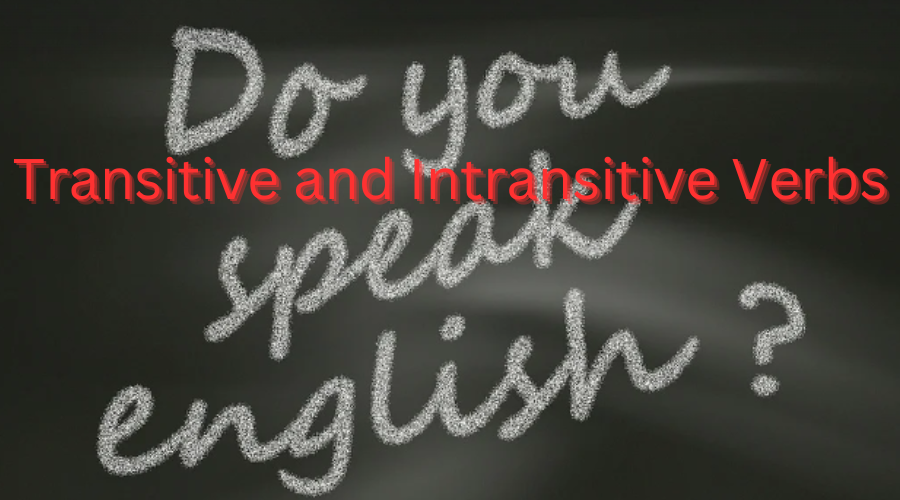Transitive and intransitive verbs are terms used to describe the relationship between the verb and its direct object in a sentence.
1. Transitive Verb:
A transitive verb is a verb that requires a direct object to complete its meaning. The action of the verb is done to someone or something.
Example: She ate an apple. (Here, ‘ate’ is a transitive verb, and ‘an apple’ is the direct object)
2. Intransitive Verb:
An intransitive verb is a verb that does not require a direct object to complete its meaning. The action of the verb does not transfer to anyone or anything; it is complete on its own.
Example: He sleeps. (Here, ‘sleeps’ is an intransitive verb. There is no direct object because the action is complete with just the subject ‘He’.)
In summary:
– Transitive verbs require a direct object to complete their meaning.
– Intransitive verbs do not require a direct object; they can stand alone.
It’s important to note that some verbs can be both transitive and intransitive, depending on the context. Let’s take the verb “run” as an example:
– Transitive usage: She ran a marathon. (Here, ‘ran’ is transitive, and ‘a marathon’ is the direct object.)
– Intransitive usage: He runs every morning. (Here, runs is intransitive; there is no direct object.)
Understanding the transitivity of verbs is crucial for constructing grammatically correct sentences and conveying clear meaning in English.
Here are some examples of transitive verbs, along with their use in sentences where a direct object completes the meaning of the verb:
1. Eat: She ate pizza for lunch.
2. Read: He read a book last night.
3. Write: They wrote letters to their friends.
4. Build: The construction workers built a house.
5. Paint: She painted the walls blue.
6. Play: The children played a game in the park.
7. Buy: We bought groceries at the store.
8. Open: He opened the door for her.
9. Teach: The professor taught a class on literature.
10. Cook: She cooked dinner for the family.
In each of these examples, the transitive verbs (eat, read, write, build, paint, play, buy, open, teach, cook) are followed by a direct object (pizza, a book, letters, a house, the walls, a game, groceries, the door, a class, dinner) that receives the action of the verb. The sentences wouldn’t be complete without these direct objects.
It’s important to note that the transitivity of a verb can sometimes depend on the context in which it is used. In certain situations, a verb may be transitive or intransitive.
The transitivity of a verb can depend on the context in which it is used. Some verbs can function as both transitive and intransitive, and their transitivity is determined by whether or not they take a direct object in a particular sentence.
For example, consider the verb “run”:
Transitive usage: She ran a marathon. (Here, ran is transitive, and a marathon is the direct object.)
-Intransitive usage: He runs every morning. (Here, ‘runs’ is intransitive; there is no direct object.)
In these examples, the verb ‘run’ changes its transitivity based on the sentence’s structure and the presence or absence of a direct object.
So, while some verbs are inherently transitive or intransitive, many verbs can be used in both ways depending on the specific context of the sentence. Understanding the context is essential for determining the transitivity of a verb in a given situation.
There are certainly verbs that are primarily transitive or intransitive, but it’s important to understand that the transitivity of a verb can be flexible and context-dependent. Some verbs may lean more toward being transitive or intransitive, but their usage can vary based on the sentence structure and context.
– Inherently Transitive Verbs: These verbs typically require a direct object to complete their meaning. Examples include “eat,” “build,” and “write.”
– She ate an apple.
– They built a sandcastle.
– He wrote a letter.
– Inherently Intransitive Verbs: These verbs do not require a direct object and can stand alone. Examples include “sleep,” “arrive,” and “run.”
– She sleeps.
– The train arrived.
– He runs every morning.
– Verbs with Flexible Transitivity: Some verbs can be used in both transitive and intransitive forms, depending on the context.
– She runs (intransitive) every morning.*
– She runs a marathon (transitive).
News in Same Category
 Ask Questions Using Would You, Could You, Will You and Can You
Ask Questions Using Would You, Could You, Will You and Can You
 Using ‘mind’ as a verb to instruct someone to be careful or take care of something
Using ‘mind’ as a verb to instruct someone to be careful or take care of something
 The term ‘mind’ to denote the act of taking care of someone or something
The term ‘mind’ to denote the act of taking care of someone or something
 He doesn’t mind, She doesn’t mind, I don’t mind
He doesn’t mind, She doesn’t mind, I don’t mind
 The Phrase “Never Mind”
The Phrase “Never Mind”
 Uses of ‘Mind’ as a Noun
Uses of ‘Mind’ as a Noun
 Uses of ‘Being’
Uses of ‘Being’
 ‘In a Nutshell’: Summarizing Complex Ideas Concisely
‘In a Nutshell’: Summarizing Complex Ideas Concisely
 Difference Between Phrase and Clause
Difference Between Phrase and Clause
 Either… or…
Either… or…
 Rather, Rather than, Rather a lot, Or rather
Rather, Rather than, Rather a lot, Or rather
 UGC opens doors for top global universities to establish campuses in India
UGC opens doors for top global universities to establish campuses in India
 JEE Advanced 2024: Key Dates and Enrollment Details Announced
JEE Advanced 2024: Key Dates and Enrollment Details Announced
 IIT Madras Launches Integrated Career Pathway Centre for Student Success
IIT Madras Launches Integrated Career Pathway Centre for Student Success
 IIM Lucknow to Soon Release CAT 2023 Answer Key
IIM Lucknow to Soon Release CAT 2023 Answer Key
 IIM Kashipur Announces Executive MBA Program for 2024, Invites Applications for EMAT-2023
IIM Kashipur Announces Executive MBA Program for 2024, Invites Applications for EMAT-2023
 ESIC Announces Examination Schedule for Group C Paramedical Posts
ESIC Announces Examination Schedule for Group C Paramedical Posts
 UKMSSB Announces Recruitment for 1455 Nursing Officer Positions: Application Process Begins on December 12
UKMSSB Announces Recruitment for 1455 Nursing Officer Positions: Application Process Begins on December 12
 How to Ask Questions in English
How to Ask Questions in English
 Auxiliary Verbs
Auxiliary Verbs














































